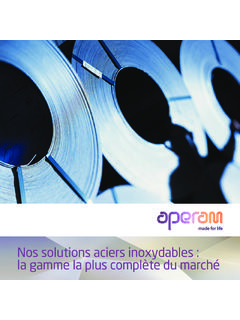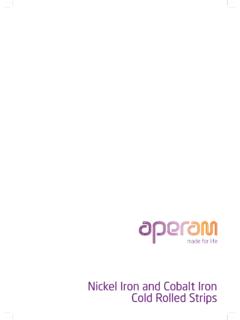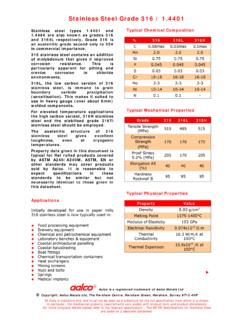Transcription of Stainless Steel and Corrosion - Aperam - About
1 Stainless Europe Stainless Steel and Corrosion What is Corrosion ? Metals, with the exception of the precious metals such What are the major factors of Corrosion ? as gold and platinum, that are found in their natural state are always extracted from ores; metals have therefore a Medium Design tendency to revert to their stable state, which corresponds Chemical nature to their original state, that is to say their oxide form. Concentration Surface state Metal Corrosion is essentially an electro-chemical reaction at Oxidising power Shape pH (acidity) Assembly (welds, rivets). the interface between metal and surrounding environment . Temperature Mechanical stresses Pressure Proximity to other metals Viscosity Contact with a medium Solid deposits (partial or total immersion).
2 Stainless Steel and the passive layer Agitation Methods of protection Steel is an alloy of iron and carbon. Contrary to carbon Steel , Corrosion factors the presence of a minimum of % chromium in the Composition Ageing of the structure Manufacturing Evolution of stresses Stainless Steel gives it the property of Corrosion resistance. Metallurgical state Temperature variability (thermal or mechanical Modification of coatings treatment) Maintenance frequency The Composition of Stainless Steel Additives It is the chromium which gives the Stainless quality to our steels. Impurities Material Time Chromium What are the 5 principal types of Corrosion linked with >10,5%. the surrounding environment ? Iron Carbon Fe+C= Steel <1,2% Fe+C+Cr= Stainless Steel generalised localised Pitting Indeed, on contact with oxygen, a chromium oxide layer is formed on the surface of the material.
3 This passive layer protects it and has the particular ability to self repair. neutral chloride Crevice Reaction of Steel and Stainless Steel in contact environment with moisture in the air or water. Steel Stainless Steel Formation of iron Formation of Under oxide (rust) chromium oxide stress O2. Fe + C Fe + C + Cr > 10,5 %. Generalised Inter- Rust granular Passive layer acid medium However if this protective layer is damaged, the start of Corrosion can appear Generalised Corrosion is noticed when Stainless Steel is In the document which follows we describe the 5 principal in contact with an acid medium and localised Corrosion is types of Corrosion and we rank the majority of Stainless seen in the majority of cases when Stainless Steel is placed Europe grades from standard laboratory tests in a neutral chloride environment However, the phenomena of Corrosion in real life are always specific, the data described does not exclude extra trials to choose the optimal material.
4 Pitting Corrosion To understand the phenomenon If the potential of the Stainless Steel in the given medium Pitting Corrosion is a local break in the passive layer of the is superior to the pitting potential =>the Stainless Steel Stainless Steel provoked by an electrolyte rich in chloride corrodes and or sulphides. At the site of the pitting, where the metal Note: the higher the pitting potential, better shall be the is unprotected, Corrosion will develop if the pit does not Corrosion resistance of the grade. Outside the pits, the re-passivate, in other words if the speed of metal dissolution passive layer is always present to protect the Stainless Steel . enables to maintain a sufficiently aggressive environment to Figure 1 shows pitting potentials obtained for different prevent its re-passivation.
5 Stainless steels in water containing NaCl (710mg/l Passive layer Cl-) at 23 C. It shows the influence on the resistance to pitting Corrosion Metal with the content of chromium and molybdenum for the ferritics, and chromium, molybdenum and nitrogen content METAL ATTACK. for the austenitics. Chlorides mV/SCE. Figure 1. Passive layer 800. Metal K44. Pitting potential in water containing pH=6,6 at 23 C (mV/SCE ). 2nd case 700. 17-11MT. 18-11ML. The metal re-passivates Corrosion of the base metal 600 K45. 18-9E/L. passive layer 18-10T K36. 17-7A/C/E 18-7L. Metal K41. 500. 16-5 MnL. 17-4Mn K39 16-4Mn This dissolution gives rise to metal ions and electrons and thus the passage of current (of dissolution) which gives rise 400. to an electrical potential difference between the anodic zone K30-K31.
6 K03. (pitting) and the cathodic zone (the rest of the metal). K09. K10. 300. Martensitic To simulate this type of Corrosion under laboratory 200. circumstances, a sample is immersed in a corrosive electrolyte to which an increasing potential is applied until the passive 10 12 14 16 18 20 22 24 26. PREN (%Cr+3,3%Mo+16%N). layer is broken. During this dynamic potential (intensity/potential) scan Norms Standards the sudden increase in intensity corresponds to the pitting Commercial ASTM. potential Epitting designations Type EN. Martensitic 420 INTENSITy K09 409 I =50 A/cm2 K03 K10 410S K30-K31 430 - K39 439 K41 441 K36 436 Epitting POTENTIAL. K45 445 Passive eld K44 444 16-4Mn 16-5Mn 201LN 17-4Mn 17-7A/C/E 301 The pitting potential corresponds to the potential 18-7L 301LN necessary to initiate stable pits.
7 18-9L 304L If the potential of the Stainless Steel in the given medium is 18-11 ML 316 - 316 L - 17-11MT 316Ti inferior to the pitting potential => pitting does not start As figures 2 and 3 show, this pitting potential can only be used to rank the grades in a given medium. It diminishes notedly when the temperature (figure 2) or the concentration of chlorides in the medium increases. (figure 3). 700 500. 450. Pitting potential in water containing NaCI pH=6,6 at 23 C (mV/SCE). Pitting potential in water containing NaCI pH=6,6 at 50 C (mV/SCE). K44 K44. 600 18-11ML. 400. 18-11ML. 500 350. 18-9E/L 300 18-9E/L. 400 K36 K36. K41. 250 K41. K39. K39. 300. 200. K30. 200 K03-K09-K10 150. K30. 100. 100. 50. K03-K09-K10. 0 0. 10 12 14 16 18 20 22 24 26 10 12 14 16 18 20 22 24 26.
8 PREN (%Cr+3,3%Mo+16%N) PREN (%Cr+3,3%Mo+16%N). Figure 2 Figure 3. In order to map the duplex range, tests in the most severe medium, NaCl ( Cl-) at 50 C, were carried out. The results obtained are shown below. Pitting potential in water containing NaCl, at 23 C and 50 C (mV/SCE). Normes Appellations ASTM. commerciales Figure 4. Designation EN. Type UNS. DX2202 2202 UNS 32202 DX2304 2304 UNS 32304 DX2205 2205 UNS 32205 Usually we use the PREN (Pitting Resistance Equivalent Number) of the grades to rank their general piting behaviour. The PREN, %Cr+ +16%N , demonstrates the major influence of these alloy elements. Our Recommendation To avoid pitting Corrosion : We would look to see if it is possible to lower the corrosiveness by lowering the temperature of the medium, limiting contact time, avoiding stagnant areas and reducing the concentration of halogens and the presence of oxidants.
9 We would choose a grade high in chromium or containing molybdenum. Crevice Corrosion To understand the phenomenon A/ Initiation of Corrosion In an electrolyte high in chloride, a confined (occluded) zone linked for example to bad design, favours the accumulation of chloride ions. The progressive acidification of the medium in this zone facilitates the de-stabilisation of the passive layer. When the pH in this zone reaches a critical value called depassivation pH , Corrosion starts. The depassivation pH or pHd is used to characterize the resistance to crevice Corrosion initiation. Why? How? Break in the passive layer Confined zone and metal attack (acidification). Some pHd values for our Stainless steels are given in figure 5. If on a recording we detect a current peak (activity), crevice The lower the value pHd the better the resistance to crevice Corrosion is starting , in the opposite case repassivation takes Corrosion .
10 Place. Activity peak measurement for a pH lower to the depassivation pH can then be considered to quantitatively compare the Figure 5: Depassivation pH of various Stainless steels in NaCl speed of crevice Corrosion propagation for different grades. 2M (71g/l Cl-) de-aerated and acidified with HCl at 23 C. This value is sensitive to the alloy elements which improve the passivity and limit active dissolution, principally molybdenum, nickel and chromium (see figure 6 ). 4. The speed of propagation is also a function of local Depassivation pH of various Stainless steels in NaCl 2M ( 71g/l Cl-). 3,5 aggressiveness and temperature of the medium. de-aerated and acidified with HCl at 23 C. 3. Figure 6: Critical current icrit at the peak of activity for 2,5. various Stainless steels in NaCl 2M (71g/l de Cl-) deaerated and acidified with HCl at 23 C.















